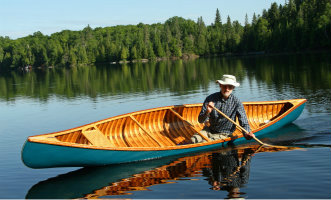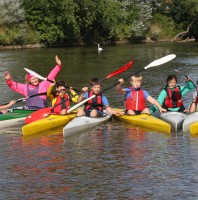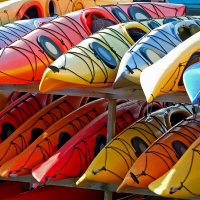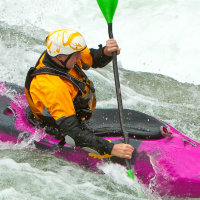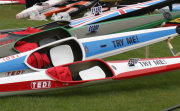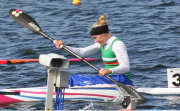Racing Paddles
If you are an expert on racing paddles and know exactly what you want you may still find our spreadsheet useful as it sets out statistics on all the blades we have come across. If you are not familiar with choosing paddles we will try to guide you through the process. If you are a coach hopefully you will find it useful to direct your paddlers to read this article to back up your advice to them.
If you think we have missed out any paddles and / or if you think any of our facts are out of date please let us know so that our information can be as comprehensive and up to date as possible.
Wings vs Asymmetrics
If you have not come across wings yet this is the first thing you need to learn about. If you haven't even seen one you may not quite "get it" until you have, but when you have seen one it will be obvious. Photo's don't always make it that clear. Wings have been around for about 25 to 30 years now and before that everyone raced with asymmetrics. Whilst it is still quite possible to paddle with asymmterics you won't see any serious racing paddlers using anything other than wings. If asymmetrics are what you have don't feel embarrassed to use them especially in the lower divisions of racing but be aware of the difference between the two types of blade. 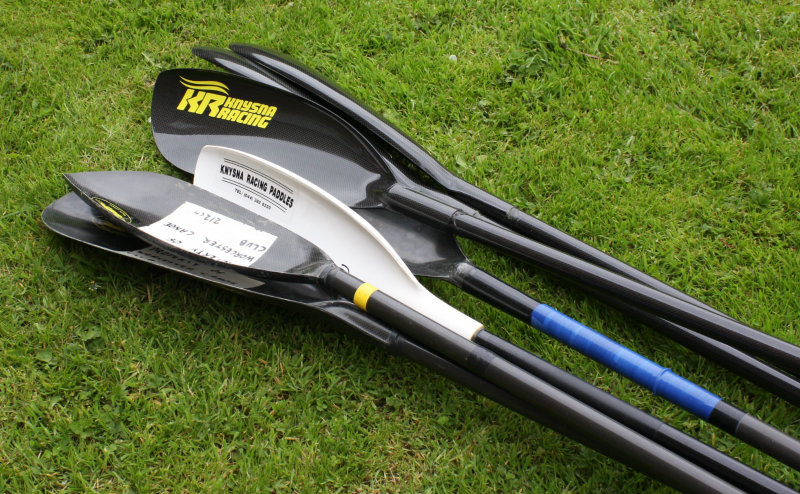 Knysa Paddles - Good Value Club Paddles Knysa Paddles - Good Value Club PaddlesWings have a spoon shape with a curled around edge that grips the water as you put the blade in. It then works in the same way as an aeroplane wing creating some lift as you drive your boat past your paddle with the paddle locked in the water. A good wing gives you a feel of stability from which to drive down into the water. By contrast an Asymmetric paddle will wobble as you load it up and will generally not feel as stable as you put lots of power down. Asymmetrics are still widely used as touring and sea kayaking paddles so to learn more about them please go to the relevant page. Here we will focus on Wings. Buy or Borrow? New or Secondhand?
These paddles are not cheap but getting your own set is really high up on your list of must haves. Even those of us who have been paddling with wings for years and years take 20 - 50 strokes to settle into a different set (or even just a very very slight change in angle). If you use a different set every time you go out for a paddle you will start every session feeling unsettled. This is really bad for your confidence especially if you are also in the process of building your confidence and stability in faster more unstable boats. As they are so expensive buying a second hand set is a really good way into ownership especially if you have a younger paddler who is growing. In many racing clubs there will be a second hand market as children grow and adults upgrade. Buying secondhand means not being too picky but holding out for something that does what you need it to do. To a certain extent you will like what you get used to. This does not necessarily mean that what you like is what will be best for you but within reason you will get used to different shaped blades. What you need to get right is the size of blade and the length. Get either of these factors wrong and you will hinder your progress and learn bad habits. So only worry about the basics not the subtlety of different shapes when buying second hand but get the size and length right. Try out a variety of makes and shapes before buying new when you have the choice and are making a bigger investment. Wing Racing Paddle Shapes
The original wing paddles were frequently called Rasmussen or Rasmussen style paddles as they were developed by Einer Rasmussen winner of 10 World Champsionship medals. These days there are two principal shapes. Most widely used are the "teardrop" shaped blades whilst parallel edge or longer thinner blades are used by some. The parallel edge blades made by Letteman were very widely used 10 years ago or so (including by some of the best paddlers in the world) but are becoming less and less common. At our club they are most commonly seen in the hands of our older paddlers who still swear by them. Between the parallel edge paddles and the tear drops are some "hybrids" that claim to provide the best of both worlds. We would suggest you start with teardrop shaped paddles if you are buying second hand and are new to wings. The teardrop shape is said to give a more powerful catch as the paddle enters the water and the parallel edge is said to be a less aggressive shape. The truth is that every paddle manufacturer's paddle is slightly different (although there are also many similarities) and some make more than one shape. When you combine that with setting paddles at slightly different angles and everyone having slightly different body mechanics there are a huge range of variables to deal with. |
Racing Paddle Stats
Below you will find a link to download a PDF file which has been created from a spreadsheet that records all the paddles we come across. It shows the different models of blade, along with the quoted area, length and width, weight, price and makers comments. We hope it will help you make sense of all the different racing paddles. Although not the only factor, paddle area is a very significant factor in how loaded up you will be for your strenght. (Shape will also play its part). GIven this and the fact that not all manfuacturers quote areas and the fact that they may not all calculate it in quite the same way, we have come up with an "area factor". Take the quoted length x width and divide by the quoted area = area factor. Factors generally come out between 106-110. If they don't either the shape is very different or one of the dimensions is suspect. Finally for those who don't quote an area we multiply the length x width and divide by an assumed area factor (your guess is as good as ours we have used 108) to calculate a comparable area. We have then classified each blade type based on its area or calculated area into a size A to G. This way you can look at all the paddles with a simliar blade area that might be worth considering according to your size and strength. Download the Spreadsheet Data Here
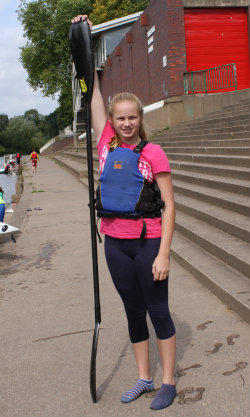 The rule of thumb that you should be able to curl your fingers over the top of the blade is a starting point but there's a lot more to it than that. The rule of thumb that you should be able to curl your fingers over the top of the blade is a starting point but there's a lot more to it than that.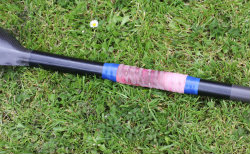 You may want to individualise your grip You may want to individualise your grip |
Wings vs Asymmetrics
If you have not come across wings yet this is the first thing you need to learn about. If you haven't even seen one you may not quite "get it" until you have, but when you have seen one it will be obvious. Photo's don't always make it that clear.
Wings have been around for about 25 to 30 years now and before that everyone raced with asymmetrics. Whilst it is still quite possible to paddle with asymmetrics you won't see any serious racing paddlers using anything other than wings. If asymmetrics are what you have don't feel embarrassed to use them especially in the lower divisions of racing but be aware of the difference between the two types of blade.
Wings have a spoon shape with a curled around edge that grips the water as you put the blade in. It then works in the same way as an aeroplane wing creating some lift as you drive your boat past your paddle with the paddle locked in the water. A good wing gives you a feel of stability from which to drive down into the water. By contrast an Asymmetric paddle will wobble as you load it up and will generally not feel as stable as you put lots of power down.
Asymmetrics are still widely used as touring and sea kayaking paddles so to learn more about them please go to the relevant page. Here we will focus on Wings.
Buy or Borrow? New or Secondhand?
These paddles are not cheap but getting your own set is really high up on your list of must haves. Even those of us who have been paddling with wings for years and years take 20 - 50 strokes to settle into a different set (or even just a very very slight change in angle). If you use a different set every time you go out for a paddle you will start every session feeling unsettled. This is really bad for your confidence especially if you are also in the process of building your confidence and stability in faster more unstable boats. As they are so expensive buying a second hand set is a really good way into ownership especially if you have a younger paddler who is growing.
In many racing clubs there will be a second hand market as children grow and adults upgrade. Buying secondhand means not being too picky but holding out for something that does what you need it to do. To a certain extent you will like what you get used to. This does not necessarily mean that what you like is what will be best for you but within reason you will get used to different shaped blades.
What you need to get right is the size of blade and the length.
Get either of these factors wrong and you will hinder your progress and learn bad habits. So only worry about the basics not the subtlety of different shapes when buying second hand but get the size and length right. Try out a variety of makes and shapes before buying new when you have the choice and are making a bigger investment.
 The rule of thumb that you should be able to curl your fingers over the top of the blade is a starting point but there's a lot more to it than that.
The rule of thumb that you should be able to curl your fingers over the top of the blade is a starting point but there's a lot more to it than that.How Long / What Size
This first table shows a Size Guide that you will find is shown against each paddle on our downloadable list of paddles and data. Based purely on the size of the blades you will be able to tell broadly which paddle might suit your size / strength. There is more to it than just blade area so we also give a secondary category where we feel that the size guide does not reflect what the area would tell us.
Size Guide
|
Area cm2
|
Example Paddle
|
Typical Paddler for this size of Racing Paddle
|
|
A |
<600 |
Guppies are 538 |
Young Junior age 8-12 |
|
B |
600-639 |
Braca Children max 635 |
Young Teenager age 12 -15 and smaller weaker women. Our Braca Childrens bought before mins and maxes are the size of the childrens maxes. Sue at 54kg and 5'4" still uses paddles this size, she is only a child at heart! |
|
C |
640-679 |
Gamma Rios Small Minus 680 |
For years there was a big jump from a range of junior paddles up to a range of paddles for small women at around 705 and bigger. This has now been filled by the Gamma Rio Small minus which is at the top end of this range and we look forward to trying. |
|
D |
680-719 |
Braca IV min 705 |
Girls / small women and growing boys |
|
E |
720-759 |
Braca IV min 735 |
Strong girls & women / boys |
|
F |
760-799 |
Braca IV max |
Very strong women / men |
|
G |
800-839 |
Braca I |
Strong men |
The Epic Kayaks website provides a Paddle Wizard that helps you select a paddle from their range along with the suggested length. When we put our details in it did a reasonable job of choosing us a paddle.
Wing Racing Paddle Shapes
The original wing paddles were frequently called Rasmussen or Rasmussen style paddles as they were developed by Einer Rasmussen winner of 10 World Championship medals. These days there are two principal shapes. Most widely used are the "teardrop" shaped blades whilst parallel edge or longer thinner blades are used by some. The parallel edge blades made by Letteman were very widely used 10 years ago or so (including by some of the best paddlers in the world) but are becoming less and less common. At our club they are most commonly seen in the hands of our older paddlers who still swear by them.
Between the parallel edge paddles
and the tear drops are some "hybrids" that claim to provide the best of
both worlds. We would suggest you start with teardrop shaped paddles if
you are buying second hand and are new to wings.
The teardrop shape is said to give a more powerful catch as the paddle enters the water and the parallel edge is said to be a less aggressive shape. The truth is that every paddle manufacturer's paddle is slightly different (although there are also many similarities) and some make more than one shape. When you combine that with setting paddles at slightly different angles and everyone having slightly different body mechanics there are a huge range of variables to deal with.
Brands
The major brands of racing paddles and our comments on them are as follows:
Brand |
Price Range
|
Comments |
|
£300 |
Wide range of syles & sizes. Very well known brand. Many people compare blade sizes to some very well known Braca standards eg. Braca I's, Braca IV mins, Braca IV maxs and Braca Childrens. UK dealer Ultimate Kayaks. | |
|
£320 |
Wide range of sizes and styles. From what we see they must have picked up some of Braca's market in recent years. We know many people who love theirs. (Emma our daughter loves hers). UK dealer Ultimate Kayaks. | |
|
£320 |
Teardrop shaped blades in a range of sizes. We've heard some people rave about these paddles (Mike has some which he is very happy with). Made in China. UK dealer Ultimate Kayaks. | |
|
£210 - £250 |
Good quality teardrop shaped paddles in 4 sizes from small kids to teens, women and mens sizes. One man band Tim Middlehurst makes these paddles, you know he will have made your paddles and they are a good all round safe bet and top quality paddle. | |
|
Wide range of racing paddles, good value if you can get hold of them. Made in South Africa so you need to import them or find an importer. we have imported tham as club paddles because they have been good value for money. | ||
|
Lettemann |
The best well known parallel edge blades for many years. Not as popular now but a tried and trusted product if that is the shape you want. Can be hard to get hold of. | |
|
Czech Republic manufacturer serving the white water racing market as well as flat water. | ||
|
Gut |
$440 |
Limited range of sizes we have heard people speak very highly of them. No experience ourselves. |
|
Streamlyte |
Sold by Marsport | |
|
£240 |
Kirton have a very good reputation for build quality. We don't know what these paddles are like for shape but Sue has a pair of Kirton paddles that she has been using for a long long time. We'd be interested to try some of their new paddles. | |
|
£160 - £295 |
South African Manufacturer. UK importer Blue Fin Kayak Racing Limited | |
|
£95 |
We've only just seen these South African paddles advertised in the UK. At this price they might represent very good value. |
Braca - Typical price £300
Wide range of syles & sizes. Very well known brand. Many people compare blade sizes to some very well known Braca standards eg. Braca I's, Braca IV mins, Braca IV maxs and Braca Childrens. UK dealer Ultimate Kayaks.
Jantex - Typical price £320
Wide range of sizes and styles. From what we see they must have picked up some of Braca's market in recent years. We know many people who love theirs. UK dealer Ultimate Kayaks.
Epic - Typical price £320
Teardrop shaped blades in a range of sizes. We've heard people really like these paddles (We / Mike have some which he is very happy with). Made in China. UK dealer Ultimate Kayaks.
Canoe Sport -Typical price £210 - £250
Good quality teardrop shaped paddles in 4 sizes from small kids to teens, women and mens sizes. One man band Tim Middlehurst makes these paddles, you know he will have made your paddles and they are a good all round safe bet and top quality paddle.
Knysna
Wide range of racing paddles, good value if you can get hold of them. Made in South Africa so you need to import them or find an importer. we have imported tham as club paddles because they have been good value for money.
Lettemann
The best well known parallel edge blades for many years. Not as popular now but a tried and trusted product if that is the shape you want. Can be hard to get hold of.
Zastera
Czech Republic manufacturer serving the white water racing market as well as flat water.
Gut - $440
Limited range of sizes we have herad peple speak very highly of them. No experience ourselves.
Streamlyte
Sold by Marsport
Kirton - Typical price £240
Kirton have a very good reputation for build quality. We don't know what these paddles are like for shape but Sue has a pair of Kirton paddles that she has been using for a long long time. We'd be interested to try some of their new paddles.
Gara - Typical Price £195
South African Manufacturer
Orka - Advertised at £95
We've only just seen these South African paddles advertised in the UK. At this price they might represent very good value.
Racing Paddle Stats
Below you will find a link to download a PDF file which has been created from a spreadsheet that records all the paddles we come across. It shows the different models of blade, along with the quoted area, length and width, weight, price and makers comments. We hope it will help you make sense of all the different racing paddles.
Although not the only factor, paddle area is a very significant factor in how loaded up you will be for your strenght. (Shape will also play its part). GIven this and the fact that not all manfuacturers quote areas and the fact that they may not all calculate it in quite the same way, we have come up with an "area factor". Take the quoted length x width and divide by the quoted area = area factor. Factors generally come out between 106-110. If they don't either the shape is very different or one of the dimensions is suspect.
Finally for those who don't quote an area we multiply the length x width and divide by an assumed area factor (your guess is as good as ours we have used 108) to calculate a comparable area.
We have then classified each blade type based on its area or calculated area into a size A to G. This way you can look at all the paddles with a simliar blade area that might be worth considering according to your size and strength.
Download the Spreadsheet Data Here
The tables below will give you some examples of the size of racing paddles used by paddlers of different height and weight. It is important to remember that each paddler is different and if you are reading this as you choose your first paddles you are unlikely to have the same strength as our top international paddlers. Even if you can bench pull a huge amount of weight you probably don't have the ability to deliver the same core strength to the paddles. So take as much notice of the paddle sizes and lengths of the paddlers with similar skills to yourself as those with ability you may only aspire to at the moment. We have only chosen paddlers who we believe are using paddles that look about right to us!
Female Athletes & their Racing Paddle choices
Paddler Profile
|
Age |
Height |
Weight |
Blade |
Length |
Category |
|
Top Class Paddler very strong |
early 20's |
5'6" |
63kg |
Canoe Sport (Braca 4 min Equivalent) |
213cm |
E |
|
Top Class Paddler very strong |
late teens |
5'8" |
71kg |
Braca VII min |
214? |
E |
|
Top Class Paddler very strong |
late teens |
5'5" |
63kg |
Jantex Medium |
215cm |
E |
|
Strong Club Paddler |
Mid Twenties |
5'8" |
70kg |
Braca IV min |
215cm |
D |
Male Athletes & their Racing Paddle choices
Paddler Profile
|
Age |
Height |
Weight |
Blade |
Length |
Category |
|
Top Class Junior Paddler |
18 |
6' |
72kg |
Jantex Medium + |
217cm |
F |
|
Top Class Junior Paddler |
18 |
6'2" |
75kg |
Epic Mid Wing |
215cm |
E |
|
Top Class Junior Paddler |
18 |
5'6" |
72kg |
Jantex Medium + |
215cm |
F |
What Shaft & What Blade Construction?
You think you've got it all sorted and you are about to place your order when the manufacturer then asks you what shaft you want and whether you want marathon or flat water construction!! Everyone you ask will have a different opinion.
Shaft Construction
Split shaft is a no brainer in our opinion. The benefits are: change your paddle angle any time you want, adjust length any time you want, can be taken apart to take on a flight, and once you have had them you realise that there are really no significant downsides.
As to the shaft itself you will be offered different stiffnesses from full carbon, to 70% carbon , etc. Certainly at the top end of the sport with very strong paddlers a very stiff shaft will give a harder catch with less give. The downside to this is the strain put on the body including wrists, shoulders, elbows etc from a catch with little give in it. For the average paddler our view is that by the time you've put a joint in the middle of the shaft (which adds rigidity) you'll be hard pressed to notice the difference between an 85% or 70% carbon shaft and a full carbon shaft and you just might not get an overuse injury that is lurking waiting to appear at an inconvenient time. This is particularly true for young paddles whose bodies are still growing and older paddlers whose bodies are starting to show signs of wear!!
The final conundrum is the possibility of cranked shafts. We recently tried some whilst sea kayaking and the guys who were using them swore that they had cured wrist problems. Having said this we also have it on good authority that whilst you may fix a wrist issue you may create shoulder problems paddling with cranks - so "you have been warned". They are not very common in the racing world but if you have wrist issues they might be worth a go, we picked them up and used them for a sea paddle without any issues at all.
Racing Paddle Blade Construction
The various manufacturers have different options available. Braca for example offer kevlar reinforced tips for marathon and down river paddling with a further two constructions one being stiff and light the other being a slightly heavier less stiff construction. Jantex offer a stiff ( for everyone) and an extra stiff ( just for the very strongest paddlers).
Light paddles certainly feel nicer in the hands so for the average paddler this would be our main concern along with reinforced tips if you are expecting to abuse them with a lot of portaging, shallow river paddling etc.
Customising your Racing Paddles
 You may want to individualise your grip
You may want to individualise your gripA lot of paddlers have a tendency for their hands to wander along the shaft as they paddle. The first way to sort this out is to put some coloured electrical tape to mark where the hands should be. Some people like different types of grip. One option is tennis racket grip, another is a piece of string under electrical tape wrapped around the shaft to sit between the index and middle fingers. Others like an oval shaft (often those who are used to white water paddling and rolling) on the right hand grip (right handers) which sits under a piece of shrink wrap.
- Home
- Your Paddles
- Kayak Paddle
- Racing Paddles
